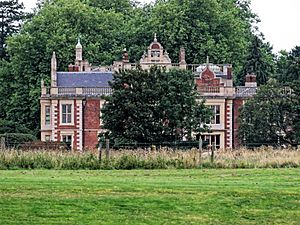Judith Barrington facts for kids
Quick facts for kids
Judith Barrington
|
|
|---|---|

Barrington Hall, Hatfield Broad Oak, Essex
|
|
| Born |
Judith Lytton
married in 1612 |
| Died | 1657 |
| Nationality | English |
| Other names | Judith Smith |
| Occupation | Estate manager |
| Known for | managing the estates of both of her husbands |
| Spouse(s) | Sir George Smith, Sir Thomas Barrington, 2nd Baronet |
| Children | two |
Judith, Lady Barrington, born Judith Lytton and also known as Judith Smith (born in the 1500s – died 1657), was an English gentlewoman. She was well-known for her amazing skills in managing large estates and for supporting religious leaders.
Contents
A Life of Management
Judith Barrington grew up in a Puritan family. Her parents lived at Annables, near Harpenden and Knebworth. Her father was a member of Parliament, which is like being a representative in the government.
First Marriage and Challenges
In 1612, Judith married Sir George Smith. They had two children together. After Sir George passed away, Judith and her two young sons faced a difficult time. They were left with many debts. However, Judith was very clever and skilled. She took charge of managing their family estate. She also became the legal guardian for her sons. People admired her for how well she handled these challenges.
A New Chapter
Judith turned down several marriage proposals before she agreed to marry Sir Thomas Barrington, 2nd Baronet. Both Judith and Sir Thomas were strong supporters of the Puritan faith. This was a religious movement that wanted to make changes to the Church of England. In 1640, a book of sermons called The Marriage of the Lambe was dedicated to Judith and her husband. This shows how much they supported Puritan clergy, who were religious leaders.
Managing Vast Estates
Judith continued to manage the estate from her first marriage. She also took on the huge task of managing her second husband's estates. This included new properties in Lincolnshire and the Isle of Wight that he inherited in 1628. Even though she had a steward (a person who helps manage an estate), Judith considered herself "the manager of all things." She made all the important decisions.
Her old notes still exist today. They show that from 1612, she was deeply involved in looking after her land and the people who lived on it. She was kind to families who had money problems, sometimes reducing their rent. She also knew a lot about trees, especially fruit trees, which was very useful for the estates.
Correspondence and Disputes
Sir Thomas Barrington, Judith's husband, was a member of the Long Parliament. This meant he spent a lot of time in London. Judith would write to him often, keeping him updated on local news. She also gave him advice on who would be a good assistant for him.
Sir Thomas passed away in 1644. After his death, Judith faced new challenges. She ended up in legal disagreements with her stepson, Sir John Barrington, 3rd Baronet. Sir John was a lawyer. He claimed that Judith was selling timber from the estate, which he said was damaging its value. There were many arguments, but experts believe that Judith had the right knowledge and was correct in her actions.
Family Connections
Judith's letters also show that she had good relationships with the rest of the Barrington family. This included her mother-in-law, Joan Barrington. Joan was also known for her excellent management skills and for supporting religious leaders.
Judith Barrington passed away in 1657. She was buried in Knebworth.

